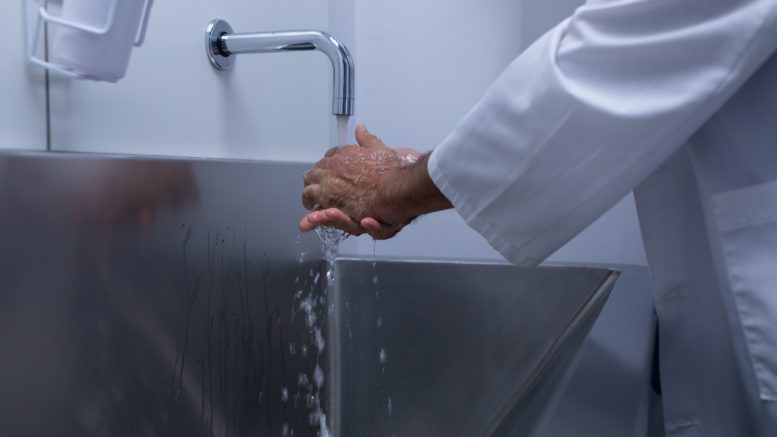Hand hygiene is the simplest, most effective way to prevent the spread of infections in healthcare, yet healthcare worker adherence is often low. Infection preventionists at two health systems will present their successful hand hygiene interventions at the Association for Professionals in Infection Control and Epidemiology (APIC)'s annual conference in Orlando June 26-28.
University of Michigan Health sustains 95% hospital-wide hand hygiene compliance through creation of interactive dashboards that visually depict data
In August 2018, University of Michigan Health, based in Ann Arbor, Mich., transitioned from using static charts to creating dynamic electronic dashboards to visualize hand hygiene compliance in real time across its 1,100-bed campus. Through use of commercially available Business Intelligence (BI) software, they generated weekly and monthly compliance reports, made month-to-month comparisons, and filtered data by unit and by role (e.g., Environmental Services, Nursing, etc.) to show the rate at which healthcare workers cleaned their hands at the appropriate moments. Details about specific missed opportunities, like a failure to perform hand hygiene prior to donning personal protective equipment, were included.
A month after the infection prevention team implemented the dashboards, 19 units improved to 95% compliance or greater from rates that were already in the high 80s. From November 2018 to February 2020 at the beginning of the pandemic, the hospital overall sustained a 95% or greater rate of adherence. Rates fell to 86% in March 2021 because the program was paused during the pandemic but have risen to 98% as of April 2023 through reintroduction and use of the dashboards and real-time data sharing.
University of Michigan Health relies on a robust team of trained observers to covertly monitor hand hygiene compliance, rather than an electronic system. ‘Secret shoppers’ track observations in the software using a mobile phone and that data is fed back to stakeholders in real time.
“We had already addressed hand hygiene at a global level at our facility and had achieved levels in the upper 80s and low 90s, but our goal was 95%,” said Harry Zhen, MPH, CIC, infection preventionist at University of Michigan Health. “The BI software allowed us to pinpoint departments and shifts that were struggling and stratify data by role types so we could have more meaningful conversations to drive improvement.”
The oral abstract, “Data Rather Than Germs on Your Fingertips: Leveraging Business Intelligence to Improve and Sustain Hand Hygiene Compliance,” is being presented June 27 at the APIC annual conference in Orlando.
Automated Hand Hygiene Monitoring Helps Newark Beth Israel Medical Center Achieve 98% Increase in Compliance
When they trialed an automated hand hygiene monitoring system (AHHMS) in 2019, Newark Beth Israel Medical Center recognized opportunities to use this technology to improve hand hygiene compliance at their 665-bed, regional care teaching hospital that provides comprehensive health care.
After a 21-day baseline period in February 2022, the hospital deployed the AHHMS in eight adult inpatient units covering about 200 patient rooms. The AHHMS senses every opportunity for hand hygiene and counts actual dispenses of hand sanitizer to compute the compliance rate.
The intervention took place over a period of 56 weeks, from March 2022 – April 2023. As part of the intervention, the infection prevention team enlisted hand hygiene champions and unit managers who shared real-time data about their units during daily safety huddles with hospital leadership and during shift transitions.
During the intervention period, the median hand hygiene rate rose significantly in all units, ranging from a 67% to 132% improvement compared to baseline. The average percent increase over baseline across all eight areas was 98%.
“The automated monitoring system provides a level of accountability that is needed to supplement existing efforts and bring about a noticeable improvement in hand hygiene,” said Ndubuisi Eke-Okoro, MSc, CIC, Newark Beth Israel Medical Center infection preventionist who helped implement the intervention. “Hospital leaders at every level are actively engaged and supportive of this effort which has been critical to our success.”
The poster, “Hand Hygiene Performance Improvement Results in Adult Acute Care Units After 56-Weeks of a Novel Intervention Program,” is being presented June 27 at the APIC annual conference in Orlando.
“Hand hygiene is the cornerstone of infection prevention, but achieving and sustaining high compliance is often elusive,” said APIC 2023 president Patricia Jackson, RN, MA, CIC, FAPIC. “We congratulate the University of Michigan Health and Newark Beth Israel for implementation of such effective programs and thank them for sharing their successful approaches at APIC’s annual conference.”
Source: APIC
